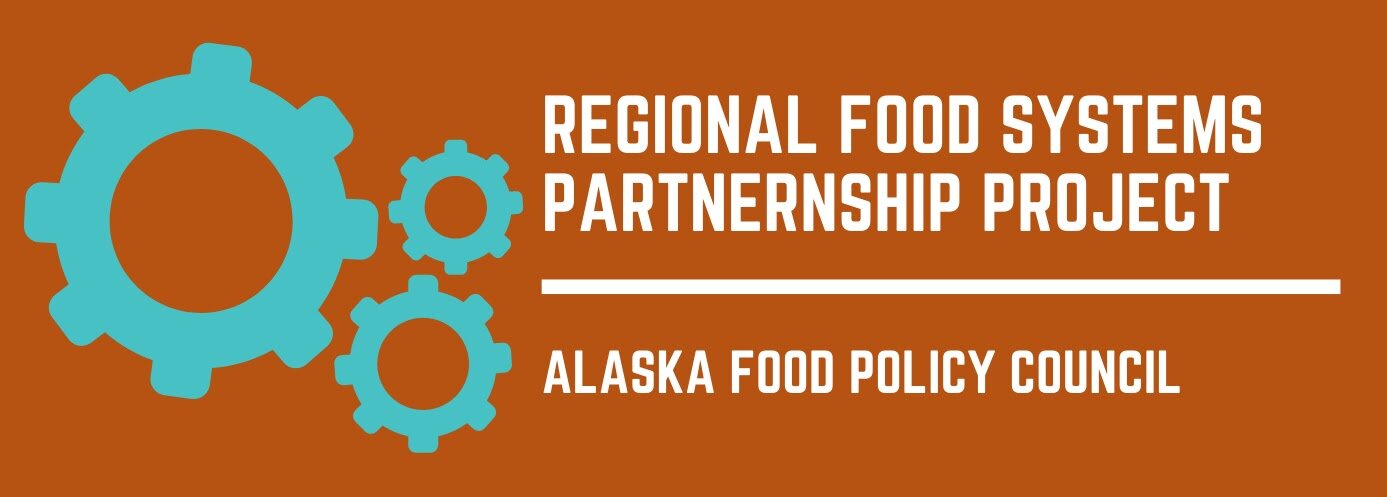Alaska Food Policy Council and Beyond: Growing Connections and Building Networks for Greater Food Security
This past October, the Alaska Food Policy Council was awarded a two-year planning grant, under the Regional Food System Partnership Program. 2020 is the first year the USDA has offered this grant program and it is part of the AMS.
The Agricultural Marketing Service (AMS) “administers programs that create domestic and international marketing opportunities for U.S. producers of food, fiber, and specialty crops. AMS also provides the agriculture industry with valuable services to ensure the quality and availability of wholesome food for consumers across the country and around the world.”
The Regional Food System Partnerships (RFSP) Program “supports partnerships that connect public and private resources to plan and develop local or regional food systems. The program focuses on strengthening the viability and resilience of regional food economies through collaboration and coordination. In 2020, USDA awarded 23 partnerships in 15 states. These projects are funded for a two- or three-year period beginning September 30, 2020.
Awards totaling $2.5 million were made to 13 Planning & Design projects. This funding supports partnerships in the early stages of convening, envisioning, and planning processes for developing local or regional food systems.
Awards totaling $6.8 million were made to 10 Implementation & Expansion projects. This funding supports partnerships building on prior or ongoing efforts within a local or regional food system.”
Our project will focus on place-based working “regional nodes” with statewide connection:
all scopes from hyper-local to borough-level, considered
utilizes a systems approach to food security planning
illuminates how parts are all connected
identifies and leverage all the assets in a community and beyond
inventories of food systems capital- from financial and social, to infrastructure and governance
Project Overview:
The Alaska Food Policy’s goal is to create a healthier, more secure, and resilient Alaska by improving our food system through advocacy, education, and connection. Our project aims to connect localized food system organizations to create a statewide network of “regional nodes.” Through direct facilitation, each node will be guided through a series of network planning discussions, including one node-specific asset mapping workshop to identify unique capacities for local food systems, while revealing barriers and system deficiencies. Through regular statewide connection, communication, and collaboration regional nodes will collectively identify linkages and partnerships which can be leveraged to create a 10-year statewide food security action plan.
The core of this project is based in democratizing the food system through network weaving: building intentional relationships and cooperative structures that can create change in a complex adaptive system.
Knowledge and learning are situated in a diversity of opinions (and places)
Building the capacity to know is as critical as what is currently known
Systems shifting networks focus on equity, inclusion, and nurturing values-based connections
Project Objectives (Nov. 2020- Sept. 2022)
Improved connection, communication, and collaboration of food system organizations/ local food policy councils, statewide for collective action at improving Alaska’s food system
Identification of community food systems assets, barriers, and capacities, with centralized Assets Library, to foster connection and collaboration
Statewide 10-year food security action plan, informed by regional Alaskan nodes representing a wide range of locations and stakeholder groups
Four Phases of the Project:
Six Virtual Session Series on Building and Nurturing Food System Networks
Session 1: The Complexity World View
Session 2: Network Building
Session 3: Network Weaving
Session 4: Asset Mapping and Affinity Groups
Session 5: Bioregional Network Activation and Design
Session 6: Reflection and Shared Vision
Statewide Survey: utilizing software SumApp survey, will create a statewide asset map. It shows us who is connected to who and how which sectors are connected to other sectors, which communities are emerging as leaders in food systems work, and where the gaps are so that strategies can be formed to strengthen and enhance network relationships.
Node Specific Mapping Workshops: This session will provide opportunities for each regional “node” to map out priorities for a sustainable food future for Alaska (items that are particular to each bioregion, taking into consideration identified assets (social, political, natural, built, cultural, etc.). This is key to amplifying voices on the ground in the process. Each node will come away with some basic goals and action steps. These data (from all nodes) will be funneled into a recommendations report so that AFPC and partners can begin crafting the larger state-wide action plan based on this information
Creation of Initial Statewide Action Plan
GOAL: to identify ways of working between communities to build a more robust Alaskan food system. Jointly, the partnership will create a multi-stakeholder action plan to address food system deficiencies through collective action. Utilizing what was gleaned from workshops and surveys, facilitators and the AFPC board and partners, we will begin to create a statewide action plan (note: this will be an ongoing process and a living document). Points of action are determined through the process with the nodes. This document will represent a food systems network that will be resilient and serve as a democratic way to bring forward the issues and priorities of Alaskans, relative to food policy.






